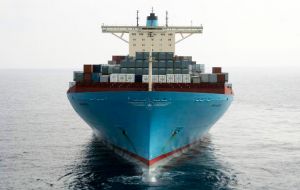MercoPress. South Atlantic News Agency
Korea's Hanjin Shipping, world's seventh largest, goes down
 Crippled with US$5.4bn in debt in August 2016, the company failed to get any more money from its creditors.
Crippled with US$5.4bn in debt in August 2016, the company failed to get any more money from its creditors.  Hanjin went into receivership and applied for court protection. No private investor or the Korean government to come to the rescue
Hanjin went into receivership and applied for court protection. No private investor or the Korean government to come to the rescue  Fellow shipping giant Maersk, earlier this month revealed a US$1.9bn net loss for 2016 - just its second annual loss since World War Two.
Fellow shipping giant Maersk, earlier this month revealed a US$1.9bn net loss for 2016 - just its second annual loss since World War Two. Hanjin Shipping used to be one of the world's top 10 shipping companies, but now it faces the final curtain. This Friday is the deadline for the firm to be declared bankrupt by a South Korean court after months of uncertainty. Hanjin's collapse is the largest to hit the shipping sector and it sent shockwaves through the industry.
For years, the global economic downturn had affected profits across the cargo shipping industry. It led to overcapacity, lower freight rates and rising debt levels. The question was not whether a big shipping line would go under, but which one would be first. The questionable honor eventually fell to Hanjin, at that time South Korea's biggest shipper and number seven in the world.
Crippled with US$5.4bn in debt in August 2016, the company failed to get any more money from its creditors. Hanjin went into receivership and applied for court protection. There was still a chance for an investor or the government to come to the rescue yet it quickly became clear that any such hopes were futile.
“Stopping the credit line immediately results in an inability to purchase fuel, it immediately results in vessels not being able to go to port and it immediately results in all customers going to the competitors,” explains Lars Jensen of Sea Intelligence Consulting. What followed were long and painful months of sailors losing their jobs and investors losing their money.
With Hanjin's situation suddenly in limbo, its ships were stranded at sea. Most ports refused them entry, fearing they would not get paid for loading and unloading the cargo. Some ships were arrested while docking as debtors had issued warrants to get at least some of their money back. Technically though, there still could have been a rescue - Hanjin needed to find an investor or convince the government to step in.
There was likely a window of some 24 to 48 hours after the announcement where Hanjin could have been saved, but after that it was simply a snowball effect and it was unrealistic to bring back the company,“ says Mr Jensen.
The chaotic demise of the company's operations did little to shore up confidence. So over the following months, many of the better assets got sold off - ranging from vessels to cargo terminals in the US to its Asia-US route operations.
The buyers were other global shipping companies that were able to cherry pick what they wanted. ”All the good assets have been sold, the carcass has been thoroughly cleaned up,“ says Greg Knowler, a maritime trade specialist at IHS.
After Friday's official bankruptcy, the court handling the liquidation process will proceed to sell off the remaining assets and give the money to the creditors. In fact, as dramatic as it was for Hanjin, for the rest of the industry the failure of one of the big players might have been a lucky break.
”This was a long time coming, it's what was widely needed,“ says Mr Knowler. ”So from this perspective this was a good thing.“
Hanjin's bankruptcy has a good chance of bringing global overcapacity in the sector down to a sustainable level. ”Everyone will be seen to have had a hard time in 2016,“ says Mr Jensen. Fellow shipping giant Maersk, for instance, earlier this month revealed a US$1.9bn net loss for 2016 - just its second annual loss since World War Two.
”2016 was the bottom of the market, but the climb upwards towards a more balanced market will take two to three years to fully accomplish,” says Mr Jensen.
Analysts agree that it is unlikely there will be another large carrier like Hanjin failing. South Korea is now left with Hyundai Merchant Marine (HMM) taking over as the country's biggest shipping company. And while last year HMM was in as much financial trouble as Hanjin, the collapse of its fellow shipper means that it is now on a much safer footing, says Mr Knowler.
“There is absolutely zero chance that the Korean government will let another major shipping line - now their only major line - fail.”




Top Comments
Disclaimer & comment rules-

-

-

Read all commentsThe bigger they are, the harder and further they fall,
Feb 17th, 2017 - 08:40 pm 0the EU will soon join this list, the way they are going.
Briton - since when diod the EU operate a shipping line? You seem to be confused between mafritime commercial companies and your paranoid phobia for a political and economic grouping.
Feb 18th, 2017 - 10:16 am 0Extrapolating your comment in line with the topic underdiscussion, you are inferring that the world's three largest shipping lines which are all European, Maersk, MSC and CMA-CGM, are all about to disappear in bankruptcy.
Before commenting on something you don't understand, please engage brain or refrain from comment.
As for the EU, don't forget that the Falklands have benefitted greatly from EU assistance and from support from the fishing lobby and protection of standards (veterinary, species and habitat, environmental) from Brussels. Hell, even the Seafood fair is located in Brussels!
It's a matter of survival of the fittest. Only the truly global carriers have the opportunity of compensating bad routes with better ones, to the contrary of smaller, niche carriers operating between regions where international trade has dropped off.
Feb 18th, 2017 - 08:12 pm 0Denmarks O.P.Moeller-Maersk already dominates more than 20% of the world's maritime trade, a move which started with the purchase of Sealand's internation shipping division from CSX back in 1999, catapulting them to the world's number one container carrier, dislodging Evergreen Marine Corporation. Since then they've expanded steadily through inorganic growth, buying up, amongst others, P&O Nedlloyd and more recently Hamburg Sud. When carriers fold (like Hanjin has), or become takeover targets, one of the main concerns of those that remain, is the need to keep on growing, in order to avoid being swallowed by the competition.
Commenting for this story is now closed.
If you have a Facebook account, become a fan and comment on our Facebook Page!